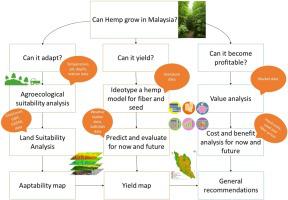Industrial Crops and Products ( IF 5.9 ) Pub Date : 2021-09-03 , DOI: 10.1016/j.indcrop.2021.113999 Eranga M. Wimalasiri 1, 2 , Ebrahim Jahanshiri 1 , Vimbayi G.P. Chimonyo 3 , Niluka Kuruppuarachchi 4 , T.A.S.T.M. Suhairi 1 , Sayed N. Azam-Ali 1 , Peter J. Gregory 1, 5

|
Hemp (Cannabis sativa L.) is a multipurpose industrial crop which is mainly cultivated in temperate regions. With its high potential for economic returns for its seeds and fiber, there is growing interest in cultivating hemp in many territories including Malaysia and other Asian countries, where its cultivation is currently illegal. To date, no comprehensive study on the suitability of this crop under Malaysian conditions has been conducted. In this paper, we propose an assessment framework as a roadmap to develop the hemp industry in Malaysia and possibly other Asian countries with equatorial climates. This framework includes suitability assessment (climate and soil), crop modelling (current and future yields under climate change) and economic analysis (net present value (NPV), NPV benefit (NPVB) and benefit-cost ratio (BCR). The land suitability assessment classified hemp as an adaptable crop for most of the land in the country. The AquaCrop model, parameterised from secondary data collected from literature was used in simulations and potential yield mapping. The estimated average potential seed and fiber yield at six locations between 2010 and 2019 was 1.61 ± 0.25 and 2.78 ± 0.39 t ha–1 respectively. Using five general circulation model (GCM) simulations, yields under future climates in Malaysia showed an increase in most of the locations. The highest NPVB of 1641 USD ha–1 (BCR of 1.33) for seed was estimated under current climate conditions. Yields of 1.38 t ha–1 (seed) and 3.62 t ha–1 (fiber) are the minimum economically feasible yields with a Benefit-Cost Ratio of 1.00 suggesting a potential for hemp cultivation in comparison to countries with established hemp industries. The present framework could be used to develop a pathway for adoption of hemp as a crop for the future in tropical countries.
中文翻译:

大麻 (Cannabis sativa L.) 作为未来热带环境作物的发展框架
大麻 ( Cannabis sativaL.) 是一种多用途的经济作物,主要种植在温带地区。由于其种子和纤维具有巨大的经济回报潜力,因此在包括马来西亚和其他亚洲国家在内的许多地区种植大麻的兴趣越来越大,目前在这些地区种植大麻是非法的。迄今为止,尚未对这种作物在马来西亚条件下的适宜性进行全面研究。在本文中,我们提出了一个评估框架,作为在马来西亚和其他可能有赤道气候的亚洲国家发展大麻产业的路线图。该框架包括适宜性评估(气候和土壤)、作物建模(气候变化下的当前和未来产量)和经济分析(净现值 (NPV)、NPV 收益 (NPVB) 和收益成本比 (BCR))。土地适宜性评估将大麻列为该国大部分土地的适应性作物。AquaCrop 模型根据从文献中收集的二级数据进行参数化,用于模拟和潜在产量绘图。2010 年至 2019 年期间六个地点的平均潜在种子和纤维产量估计为 1.61 ± 0.25 和 2.78 ± 0.39 吨公顷–1分别。使用五个大环流模型 (GCM) 模拟,马来西亚未来气候下的产量在大多数地区都有所增加。在当前气候条件下,估计种子的最高 NPVB 为 1641 美元 ha –1(BCR 为 1.33)。1.38 t ha –1(种子)和 3.62 t ha –1(纤维)的产量是经济上可行的最低产量,效益成本比为 1.00,表明与已建立大麻产业的国家相比,大麻种植潜力巨大。目前的框架可用于开发一条途径,在热带国家采用大麻作为未来的作物。

























 京公网安备 11010802027423号
京公网安备 11010802027423号